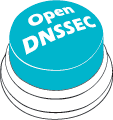How-to
How do I...?
Although under the hood a lot has changed in OpenDNSSEC 2.0, the architecture and workflow has more in common with OpenDNSSEC 1.4 than it differs. This 'HOWTO' will initially focus on procedures that have changed or are formerly not possible.
Upgrade OpenDNSSEC 1.4.10 to OpenDNSSEC 2.0
With the rewrite of the ods-enforcerd daemon the database layout has changed as well. Upgrade scripts for Sqlite3 and MySQL are provided in the source tarball in enforcer/utils/1.4-2.0_db_convert. See ("Migration from 1.4 to 2.1")[https://www.opendnssec.org/migration-from-1-4-to-2-1/] for more information. The text file README.md in that directory explains the process. Note: while 1.4 supplied scripts to convert from one database backend to the other, 2.0 does not have these yet. If you are planning to change database backend do that first before upgrading OpenDNSSEC.
Perform an non-scheduled key rollover
OpenDNSSEC can perform a key rollover at any time. It does not matter if another rollover is already happening.
ods-enforcer key rollover -z example.com -t ZSK
The next scheduled rollover (unless
Change a policy configuration
A zone is tied to a policy, and policies are described in kasp.xml in /etc/opendnssec. The 2.0 enforcer will store policy timing information per key in its database. As a result all TTL values can safely be changed without running the risk of a zone become bogus during a current or future rollover. In contrast, if one would shorten a TTL in 1.4 the next rollover has a change to be performed to quickly as the records would still be in cache with the old, long TTL. After editing the policy in kasp.xml one should issue a policy import and urge the Enforcer to see if there is any work to do on the zones.
ods-enforcer policy import
ods-enforcer enforce
There is no need to restart the enforcer. In fact, the KASP is not being read on startup. Any new keys will use the new timings.
Change the signing algorithm
Changing the algorithm is no different than changing other policy parameters. Change the <Algorithm> field in the KASP (make sure to do this for both KSK and ZSK) and run policy import.
ods-enforcer policy import
ods-enforcer enforce
Clear all state and start over
Suppose you are testing OpenDNSSEC in your environent and at some point want to reset is to be like a fresh installed instance. The main thing to do is run ods-enforcer-db-setup (after stopping OpenDNSSEC entirely). The Enforcer database is then clean and empty. We still need to files from /var to make sure the Signer isn't still using old data.
rm /var/opendnssec/enforcer/zones.xml
rm /var/opendnssec/signconf/*
rm /var/opendnssec/signer/*
ods-enforcer-db-setup
Stop using DNSSEC for a zone
If it is no longer desired to sign a zone, OpenDNSSEC can help to stop signing in a safe way. The zone will become insecure without running the risk of some validators to see a bogus zone. The way to do it is to configure no keys in its policy. The Enforcer will then retract the current keys as soon as possible.
For example the configuration file kasp.xml:
<Keys>
<TTL>PT3600S</TTL>
<RetireSafety>PT3600S</RetireSafety>
<PublishSafety>PT3600S</PublishSafety>
<Purge>P14D</Purge>
<KSK>
<Algorithm length="2048">8</Algorithm>
<Lifetime>P1Y</Lifetime>
<Repository>SoftHSM</Repository>
</KSK>
<ZSK>
<Algorithm length="1024">8</Algorithm>
<Lifetime>P90D</Lifetime>
<Repository>SoftHSM</Repository>
</ZSK>
</Keys>
Will become:
<Keys>
<TTL>PT3600S</TTL>
<RetireSafety>PT3600S</RetireSafety>
<PublishSafety>PT3600S</PublishSafety>
<Purge>P14D</Purge>
</Keys>
After this you must instruct the Enforcer to reread the policy and reevaluate the zones.
ods-enforcer policy import
ods-enforcer enforce
Use a single key as ZSK and KSK
New in OpenDNSSEC 2.0 is the support for CSK's (Combined Signing Key) Which take the role of KSK and ZSK. Its configuration is exactly like that of the other types but uses the
<Keys>
<TTL>PT3600S</TTL>
<RetireSafety>PT3600S</RetireSafety>
<PublishSafety>PT3600S</PublishSafety>
<Purge>P14D</Purge>
<CSK>
<Algorithm length="2048">8</Algorithm>
<Lifetime>P1Y</Lifetime>
<Repository>SoftHSM</Repository>
</CSK>
</Keys>
It is entirely possible to roll from a split key (KSK+ZSK) policy to a single key policy (CSK) and vice versa by changing the policy.
Get a parsable version of key list
The -p (or --parsable) is added to ods-enforcer key list to aid processing and monitoring of the key states by an external process. key list -v and key list -d accept this flag. The information outputted and order remains the same.
$ ods-enforcer key list -z example.com -d 2>/dev/null
Keys: Zone: Key role: DS: DNSKEY: RRSIGDNSKEY: RRSIG: Pub: Act: Id: example.com KSK rumoured omnipresent omnipresent NA 1 1 7a188b4177bed1a744c1bcb9aa4362cf example.com ZSK NA omnipresent NA omnipresent 1 1 1c86793b7b779d935756906ec7fd28f7
$ ods-enforcer key list -z example.com -d -p 2>/dev/null example.com;KSK;rumoured;omnipresent;omnipresent;NA;1;1;7a188b4177bed1a744c1bcb9aa4362cf example.com;ZSK;NA;omnipresent;NA;omnipresent;1;1;1c86793b7b779d935756906ec7fd28f7
Passing zones through OpenDNSSEC unsigned
It is possible to pass zones through OpenDNSSEC without signing them. It's useful if you want to have the same work flow for OpenDNSSEC signed and unsigned (or externally signed) zones. To achieve this add the <Passthrough/> element to the policy like so:
<KASP>
<Policy name="default">
<Passthrough/>
<Description>A default policy that will amaze you and your friends</Description>
<Signatures>
...
...
</Policy>
...
</KASP>
Most of the following parameters such as TTLs and algorithms will not be used for this zone. They are still required to be present however, like in any other policy. Please also note that this is different than defining a policy without keys. A policy without keys will get its DNSSEC related records stripped.
Change Database Backend
If you are running OpenDNSSEC and want to change its used database backend there are three steps involved:
- Change database settings in conf.xml
- Create database
- Convert the database
To accommodate step 3 we provided two scripts: convert_mysql_to_sqlite and convert_sqlite_to_mysql both located in enforcer/utils. Usages:
1: usage: ./convert_mysql_to_sqlite -i DATABASE_MYSQL -o DATABASE_SQLITE [-h HOST] [-u USER] [-p PASSWORD]
2: usage: ./convert_sqlite_to_mysql -i DATABASE_SQLITE -o DATABASE_MYSQL [-h HOST] [-u USER] [-p PASSWORD]
- DATBASE_MYSQL, Name of the MySQL database. Make sure you created the database beforehand.
- DATABASE_SQLITE, Path of SQLite database file. Will overwrite existing file
- HOST, USER, PASSWORD apply to the MySQL database. HOST will default to localhost.
When creating a SQLite database make sure the resulting file is readable and writable for the user OpenDNSSEC runs as.


